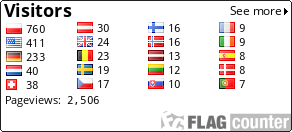Geologia jest dla wszystkich!
Geology is for Everyone!
 [PL]
[PL]
Poniewaz muzea nie moga byc uznawane za Earthcache, a jedno z miejsc, jakie odwiedzicie przy tym keszu to Muzeum Ziemi w Warszawie, wasze przygoda zaczyna sie przed budynkiem Muzeum w miejscu wskazanym koordynatami startowymi. Wszystkie zdjecia pokazane przy tym keszu zostaly wykonane przeze mnie na terenie muzeum lub przed nim.
Muzeum jest czynne w godzinach: poniedzialek-piatek 09.00-16.00 / niedziela 10.00-16.00. W soboty muzeum jest nieczynne. Wstep do muzeum jest platny (4 PLN / 1 EUR), w niedziele wstep darmowy. Wiecej o muzeum na jego stronie.
Przed budynkami znajduje sie ulica-parking, dookola ktorego wystawionych jest kilka glazow narzutowych, ktore zostaly wydobyte w czasie roznych prac budowlanych w okolicach Warszawy. Wszystkie te glazy pochodza ze Skandynawii. Zostaly przyniesione na tereny Mazowsza w trakcie przedostatniego na terenach Polski zlodowacenia srodkowopolskiego, ktore mialo miejsce trwalo od ok. 215 do 130 tysiecy lat temu (ta czesc zalodowacenia nosi nazwe zlodowacenia Warty). Na tablicy, ktora znajduje sie na plocie terenu Muzeum mozecie zobaczyc, skad przywedrowywaly do nas glazy narzutowe.
Zgromadzone przed Muzeum glazy sa najwiekszym skupiskiem glazow narzutowych w Warszawie. Pierwszym zadaniem potrzebnych do zaliczenia tego Earthcache’a jest zmierzenie/ocenienie wysokosci srodkowego glazu narzutowego, ktory znajduje sie na srodku ulicy (na zdjeciu zaznaczony jest strzalka).
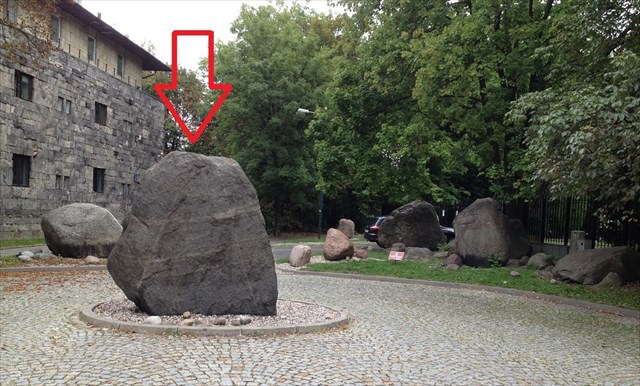
Udajcie sie nastepnie w strone budynku glownego Muzeum.
Przed wejsciem, lekko zamaskowany krzakami, lezy skamieniale drzewo. Jest to Pomnik Przyrody, co chyba nie jest dziwne, zwazywszy, iz zylo ono w karbonie, czyli okolo 280 milionow lat temu! Zachowujac nalezyta ostroznosc, bez zblizania sie do pnia drzewo oszacuj jego dlugosc. Jest to drugie zadanie potrzebne do zaliczenia tego Earthcache’a.
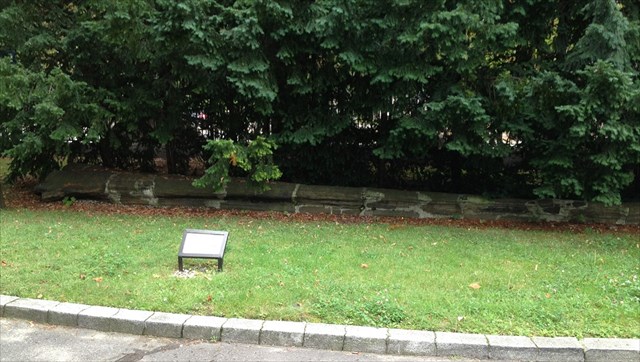
Zanim zaprosze Was do wejscia do srodka Muzeum, przejdzmy na jego tyły. Na zewnatrz wystawione sa materialy budowlane pochodzace z roznych rodzajow skal wydobyte na terenie Polski. Przypatrzcie sie im uwaznie i wykonajcie dwa pomiary:
٠ Zmierzcie srednice wiekszego kola mlynskiego pochodzacego z Dolnego Slaska. Z jakiego materialu jest ono wykonane?
٠ Zmierzcie obwod bazaltowego slupa pochodzacego z Janowa Dolnego.
Odpowiedzi na te dwa powyzsze zadania nie sa obowiazkowe.

Nastepne zadania wymagaja odwiedzenia Muzeum, a wiec zapraszam do srodka.
Przy samym wejsciu mozemy zobaczyc skamienialosci, jakie zostaly wydobyte z dna rzeki Narew w miejscu, ktore obecnie jest Jeziorem Zegrzynskim (niektorzy nazywaja go niepoprawnie Zalewem Zegrzynskim). W trakcie prac przed 50 laty wydobyto je z dna rzeki i byly one przechowywane w jednej ze szkol w Serocku. Dopiero niedawno trafily do zbiorow Muzeum, gdzie mozna je podziwiac.
W miejscu stalej ekspozycji czekaja na Was kolejne opcjonalne zadania.
Na wystawie znajduje sie duzy pegmatyt, na ktorym widoczne sa duze krysztaly morionu (czarnego kwarcu). Pegmatyt pochodzi z okolic Strzegomia. Waszym zadaniem jest policzyc ile duzych krysztalow kwarcu widac na wyeksponowanym Pegmatycie. Czy potraficie zmierzyc katy tworzone przez wszystkie sciany wybranego krysztalu morionu? Jezeli tak, to w jaki najprostszy sposob wykonali byscie to zadanie?
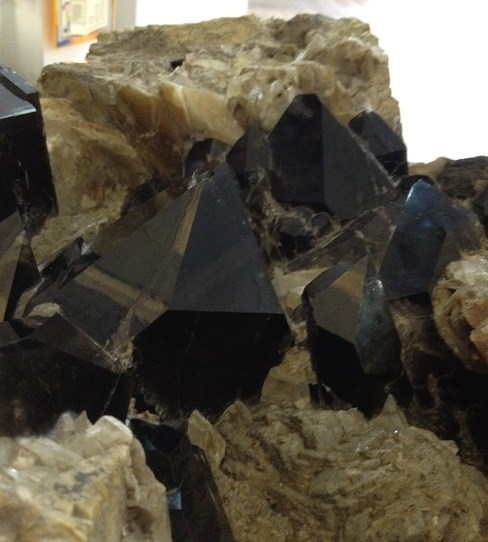
Nastepnym etapem naszej podrozy po Muzeum beda odwiedziny w drugim budynku Muzeum (wejscie na ten sam bilet co na ekspozycje w budynku glownym Muzeum) – willi Pniewskiego, ktory znajduje sie po drugiej stronie ulicy. (Czy wiesz, ze wizyta w tej willi jest niezbedna do odnalezienia cache’a CT7: Villa Pniewski?) W drugim budynku znajduja sie miedzy innymi dwie interesujace ekspozycje pokazujace skamienialosci odkryte na terenie Warszawy oraz piekne mineraly.
Zajmijmy sie najpierw skamienialosciami. Na pewno od razu zauwazycie duza noge – przednia konczyne slonia lesnego, jednego z najwiekszych na swiecie sloniowatych (Palaeoloxodon antiquus):
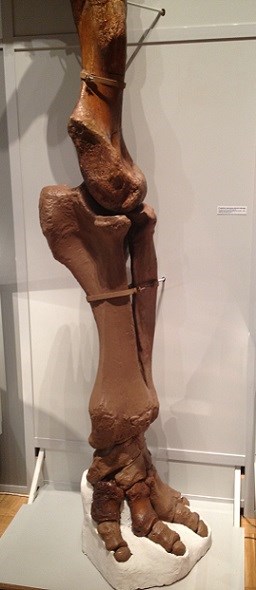 Ta skamienialosc zostala wydobyta w trakcie prac budowlanych w Warszawie na ulicy Leszno. Obok znajduja sie skamienialosci szczatkow nosorozca lesnego (Dicerorhinus kirchbergensis), ktore zostaly wydobyte z dna Wisly w okolicach mostu Siekierkowskiego w trakcie poglebiania rzeki oraz czaszke i kosci tura (Bos primigenius), gatunku, ktorego ostatni osobnik padl w Puszczy Jaktorowskiej w roku 1627. Zadanie wymagane do zaliczenia Earthcache’a jest nastepujace: podaj wysokosc jaka osiagaly zyjace na terenie Polski slonie lesne. Podpowiedz – oszacuj ja na podstawie wysokosci pokazanej skamienialosci albo obejrzyj przygotowana prezentacje multimedialna.
Ta skamienialosc zostala wydobyta w trakcie prac budowlanych w Warszawie na ulicy Leszno. Obok znajduja sie skamienialosci szczatkow nosorozca lesnego (Dicerorhinus kirchbergensis), ktore zostaly wydobyte z dna Wisly w okolicach mostu Siekierkowskiego w trakcie poglebiania rzeki oraz czaszke i kosci tura (Bos primigenius), gatunku, ktorego ostatni osobnik padl w Puszczy Jaktorowskiej w roku 1627. Zadanie wymagane do zaliczenia Earthcache’a jest nastepujace: podaj wysokosc jaka osiagaly zyjace na terenie Polski slonie lesne. Podpowiedz – oszacuj ja na podstawie wysokosci pokazanej skamienialosci albo obejrzyj przygotowana prezentacje multimedialna.
Bedac na tej samej sali odszukaj specjalnie przygotowana ekspozycje mineralow, ktore swieca w swietle UV. Czy wiesz dlaczego tylko niektore mineraly zachowuja sie w ten sposob? Jaka jest przyczyna, ze ten sam mineral moze w jednym przypadku swiecic w swietle UV a druga probka takiego samego mineralu nie? Przyjrzyj sie wyeksponowanym probkom i pobaw sie wylacznikiem swiatla UV. Na jaki kolor świeci probka fluorytu z Freibergu, a na jaki kolor swieci apatyt z Franklin? Odpowiedzi na powyzsze trzy pytania sa kolejnym zadaniem – tym razem opcjonalnym.

Czy podobala sie Wam wycieczka po swiecie geologii i paleontologii? Jezeli tak, to na pewno jeszcze nie raz wrocicie do Muzeum Ziemi! Ponizej jeszcze raz komplet zadan dla cache’a „Geologia jest dla Wszystkich”:
1. Oszacuj wysokosc najwyzszego, centralnego glazu narzutowego znajdujacego sie przed Muzeum Ziemi
2. Oszacuj dlugosc skamienialego drzewa znajdujacego sie przed wejsciem do Muzeum Ziemi
3. Podaj wysokosc jaka osiagaly zyjace na terenie Polski slonie lesne.
Zadania opcjonalne:
4. Zmierz srednice wiekszego kola mlynskiego pochodzacego z Dolnego Slaska. Podaj z jakiego materialu jest ono wykonane?
5. Zmierz obwod bazaltowego slupa pochodzacego z Janowa.
6. Policz ile duzych krysztalow kwarcu widac na wyeksponowanym pegmatycie. Czy potraficie zmierzyc katy tworzone przez wszystkie sciany wybranego krysztalu morionu? Jezeli tak, to w jaki najprostszy sposob wykonalibyscie to zadanie?
7. Dlaczego tylko niektore mineraly swieca w momencie, gdy oswietlimy je swiatlem UV? Jaka jest przyczyna, ze ten sam mineral moze w jednym przypadku swiecic w swietle UV a druga probka takiego samego mineralu nie? Na jaki kolor świeci probka fluorytu z Freibergu, a na jaki kolor swieci apatyt z Franklin?
Odpowiedzi prosze przesylac poprzez formularz kontaktowy na moim profilu. Nie trzeba czekac na odpowiedz, mozna od razu logowac odnalezienie Earthcache'a. Jesli odpowiedz bedzie niepoprawna, zglosze sie sam. Logi bez potwierdzenia mailowego beda kasowane!
Osoby, ktore odpowiedza na wszystkie pytania (tj. rowniez pytania opcjonalne) moga umiescic na swoim profilu obrazek:
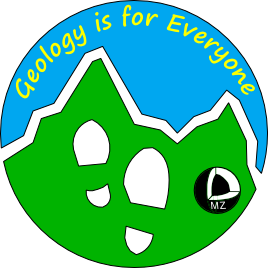
W tym celu nalezy skopiowac ponizszy kod i umiescic go w swoim profilu:
<a href="http://coord.info/GC4KJR2" target="_blank"><img src="http://img.geocaching.com/cache/large/c3b0a8b5-b965-4f56-97f4-a39c66258daa.png?rnd=0.6801072" width="140" alt="Found earthcache in Warsaw (PL): 'Geologia jest dla Wszystkich'" title="Found earthcache in Warsaw (PL): 'Geologia jest dla wszystkich'" /></a>
 [EN]
[EN]
I would like to invite you for a trip through geology and paleontology. Museums are not allowed to be EC, so for that reason we are starting our activities outside of Museum of the Earth at the place shown by given coordinates.
Museum is open: Monday – Friday 09:00 – 16:00, Sunday 10:00 – 16:00. Saturday is closed day. Ticket to the Museum costs about 1 Euro, Sunday is a day with free entry.
In front of museum buildings at the place shown by coordinates one may spot several erratics that have been taken during the various construction works in the vicinity of Warsaw. All of these erratics originate from Scandinavia. They have been brought to the Mazovia area during the Warta glaciation, which took place about 250 to 130 thousand years ago.
All erratics gathered in front of museum are the biggest cluster of erratics in Warsaw. The first task you need to complete this Earthcache'a to measure (or to assess) the height of your erratic, which is located in the middle of the street (it is marked by arrow on the picture below).

Now go toward the main building of the museum. At the entrance, slightly camouflaged with bushes, lies fossilized tree. It is a natural monument, which was alive in the Carboniferous, which is 280 million years ago! With all due caution, without approaching the tree trunk estimate its length. This is the second task required to complete this Earthcache.

Before going inside the museum, let's move to its back yard. There is an exhibition of building materials that are drawn from different types of rocks excavated in Poland. Observe them carefully and perform the two measurements:
٠ Measure the diameter of bigger millstone coming from Lower Silesia. What material is it made of?
٠ Measure the circumference of basalt pole coming from Janow Dolny.
The answers to these two tasks are not mandatory.

All following tasks require the visit inside the Museum, so let’s go.
At the entrance we can see fossils that have been recovered from the bottom of the Narew river, which is now transformed into Zegrze Lake. During that work 50 years ago, fossils were extracted from the bottom of the river and they were stored in one of the schools in Serock. It was only recently added to the collections Museum, where you can admire them.
Next optional task awaits you in place of permanent exhibition. You may find large pegmatite, with visible large crystals of morion (black quartz). Pegmatite comes from the Strzegom area. Your task is to count the number of large quartz crystals. Can you to measure all the angles of the walls of the selected morion crystal? If so, what is the most simple way to do this task?

The next stage of our trip will be the visit in the second building of Museum (entrance on the same ticket as the exposition of the museum's main building) - Pniewski villa, which is located across the street. (Did you know that a visit to this villa is necessary to find the cache CT7: Villa Pniewski?) Inside second building you may find two interesting exhibitions which show a fossils discovered in Warsaw and beautiful minerals.
Let's start with fossils first. Right after you enter the exhibition you will notice big leg - front limbs forest elephant, one of the world's largest Elephantidae (Palaeoloxodon antiquus):
 This fossil was excavated during construction works in Warsaw on Leszno Street. Next to it you may see fossil remains of forest rhinoceros (Dicerorhinus kirchbergensis) that have been extracted from from Vistula in the vicinity of the Siekierkowski bridge during the deepening of the river, and the skull and bones of aurochs (Bos primigenius), a species whose last specimen died in Jaktorow Forest in 1627.
This fossil was excavated during construction works in Warsaw on Leszno Street. Next to it you may see fossil remains of forest rhinoceros (Dicerorhinus kirchbergensis) that have been extracted from from Vistula in the vicinity of the Siekierkowski bridge during the deepening of the river, and the skull and bones of aurochs (Bos primigenius), a species whose last specimen died in Jaktorow Forest in 1627.
The obligatory task is the following: Specify the height of forest elephants, which used to live in Poland. Hint - estimate the height on the basis of shown fossil or watch prepared multimedia presentation.
Being in the same room please pay some attention to specially prepared expositions of minerals that glow in UV light. Do you know why only some minerals behave in this way? What is the reason that the same mineral in one case may shine in UV light and a second sample of the same mineral, is not? Look on the exposed samples and play with the UV light switch. In what color specimen of fluorite from Freiberg shines, and in what color apatite from Franklin shines? The answers to three questions are the next task - this time optional.

Did you enjoy you trip to the world of geology and paleontology? If so, you will definitely come back again and again to the Museum of the Earth! Below you may find whole set of tasks for earthcache "Geology is for Everyone":
1. Estimate the height of the tallest, central erratic that lies in front of the Museum of the Earth
2. Estimate the length of fossilized tree that lies in front of entrance to the Museum of the Earth
3. Estimate the height of forest elephants that used to live on territory of Poland.
Optional tasks:
4. Measure the diameter of bigger millstone coming from Lower Silesia. What material is it made of?
5. Measure the circumference of basalt pole coming from Janow Dolny.
6. Count how many large quartz crystals can be seen on the exposed pegmatite. Can you to measure all the angles of the walls of the selected crystal morion? If so, what is the simplest way to do that job?
7. Why only some minerals shine in a time when they are illuminated by UV light? What is the reason that the same mineral in one case may shine in UV light and a second sample of the same mineral, is not? Look on the exposed samples and play with the UV light switch. In what color specimen of fluorite from Freiberg shines, and in what color apatite from Franklin shines?
Please send me your answers through the contact form on my profile. You don;t have to wait for my confirmation - please log your EC immediately. I will contact you if needed. Logs without the answers will be deleted!
Those of you, who will answer to all questions (it means obligatory and optional ones) may pimp their profile with following badge:

All you have to do is to copy following code into your profile:
<a href="http://coord.info/GC4KJR2" target="_blank"><img src="http://img.geocaching.com/cache/large/c3b0a8b5-b965-4f56-97f4-a39c66258daa.png?rnd=0.6801072" width="140" alt="Found earthcache in Warsaw (PL): 'Geology is for Everyone'" title="Found earthcache in Warsaw (PL): Geology is for Everyone'" /></a>
Earthcaches are cool, just think and cache them ;))

